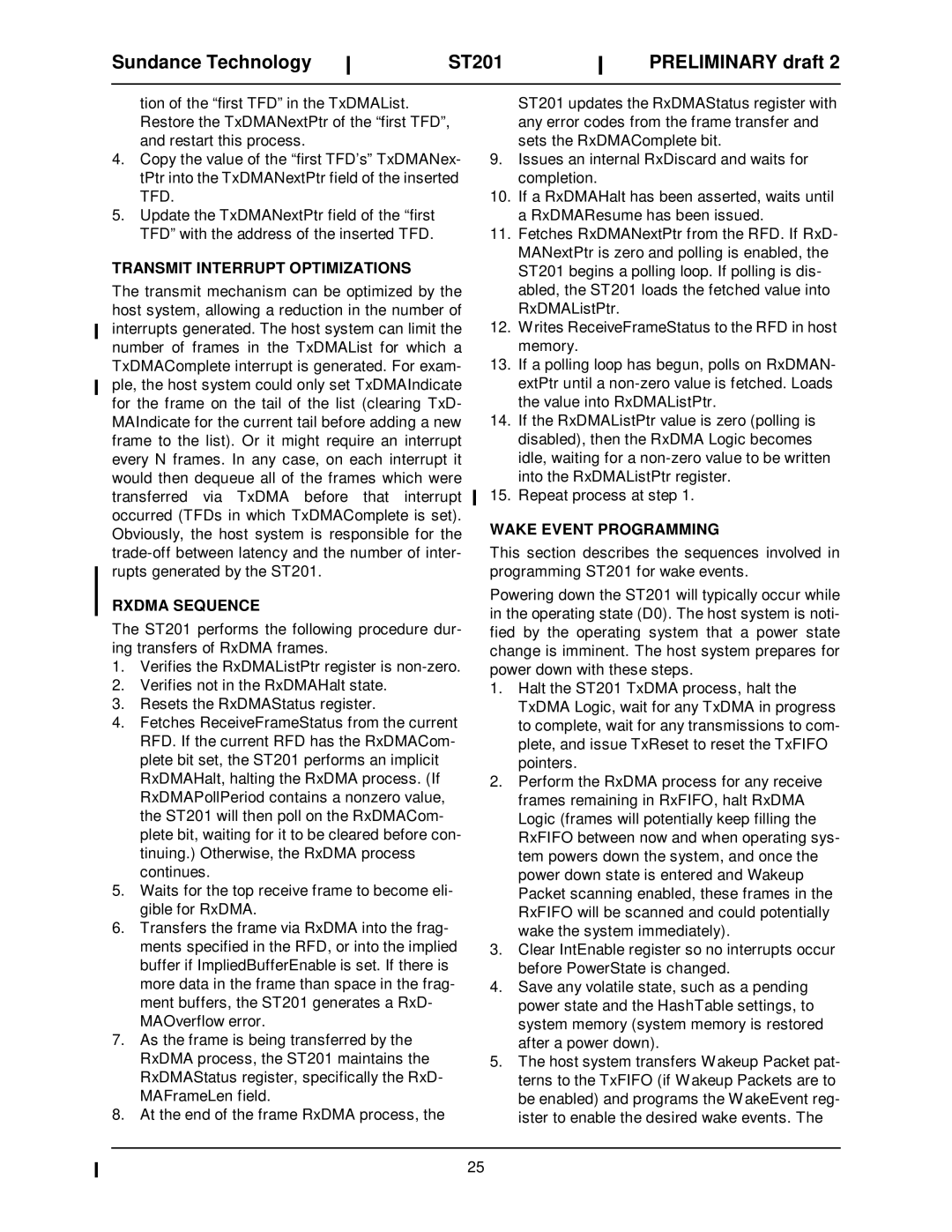
Sundance Technology
ST201
PRELIMINARY draft 2
tion of the “first TFD”in the TxDMAList. Restore the TxDMANextPtr of the “first TFD”, and restart this process.
4.Copy the value of the “first TFD’s”TxDMANex- tPtr into the TxDMANextPtr field of the inserted TFD.
5.Update the TxDMANextPtr field of the “first TFD”with the address of the inserted TFD.
TRANSMIT INTERRUPT OPTIMIZATIONS
The transmit mechanism can be optimized by the host system, allowing a reduction in the number of interrupts generated. The host system can limit the number of frames in the TxDMAList for which a TxDMAComplete interrupt is generated. For exam- ple, the host system could only set TxDMAIndicate for the frame on the tail of the list (clearing TxD- MAIndicate for the current tail before adding a new frame to the list). Or it might require an interrupt every N frames. In any case, on each interrupt it would then dequeue all of the frames which were transferred via TxDMA before that interrupt occurred (TFDs in which TxDMAComplete is set). Obviously, the host system is responsible for the
RXDMA SEQUENCE
The ST201 performs the following procedure dur- ing transfers of RxDMA frames.
1.Verifies the RxDMAListPtr register is
2.Verifies not in the RxDMAHalt state.
3.Resets the RxDMAStatus register.
4.Fetches ReceiveFrameStatus from the current RFD. If the current RFD has the RxDMACom- plete bit set, the ST201 performs an implicit RxDMAHalt, halting the RxDMA process. (If RxDMAPollPeriod contains a nonzero value, the ST201 will then poll on the RxDMACom- plete bit, waiting for it to be cleared before con- tinuing.) Otherwise, the RxDMA process continues.
5.Waits for the top receive frame to become eli- gible for RxDMA.
6.Transfers the frame via RxDMA into the frag- ments specified in the RFD, or into the implied buffer if ImpliedBufferEnable is set. If there is more data in the frame than space in the frag- ment buffers, the ST201 generates a RxD- MAOverflow error.
7.As the frame is being transferred by the RxDMA process, the ST201 maintains the RxDMAStatus register, specifically the RxD- MAFrameLen field.
8.At the end of the frame RxDMA process, the
ST201 updates the RxDMAStatus register with any error codes from the frame transfer and sets the RxDMAComplete bit.
9.Issues an internal RxDiscard and waits for completion.
10.If a RxDMAHalt has been asserted, waits until a RxDMAResume has been issued.
11.Fetches RxDMANextPtr from the RFD. If RxD- MANextPtr is zero and polling is enabled, the ST201 begins a polling loop. If polling is dis- abled, the ST201 loads the fetched value into RxDMAListPtr.
12.Writes ReceiveFrameStatus to the RFD in host memory.
13.If a polling loop has begun, polls on RxDMAN- extPtr until a
14.If the RxDMAListPtr value is zero (polling is disabled), then the RxDMA Logic becomes idle, waiting for a
15.Repeat process at step 1.
WAKE EVENT PROGRAMMING
This section describes the sequences involved in programming ST201 for wake events.
Powering down the ST201 will typically occur while in the operating state (D0). The host system is noti- fied by the operating system that a power state change is imminent. The host system prepares for power down with these steps.
1.Halt the ST201 TxDMA process, halt the TxDMA Logic, wait for any TxDMA in progress to complete, wait for any transmissions to com- plete, and issue TxReset to reset the TxFIFO pointers.
2.Perform the RxDMA process for any receive frames remaining in RxFIFO, halt RxDMA Logic (frames will potentially keep filling the RxFIFO between now and when operating sys- tem powers down the system, and once the power down state is entered and Wakeup Packet scanning enabled, these frames in the RxFIFO will be scanned and could potentially wake the system immediately).
3.Clear IntEnable register so no interrupts occur before PowerState is changed.
4.Save any volatile state, such as a pending power state and the HashTable settings, to system memory (system memory is restored after a power down).
5.The host system transfers Wakeup Packet pat- terns to the TxFIFO (if Wakeup Packets are to be enabled) and programs the WakeEvent reg- ister to enable the desired wake events. The
25
